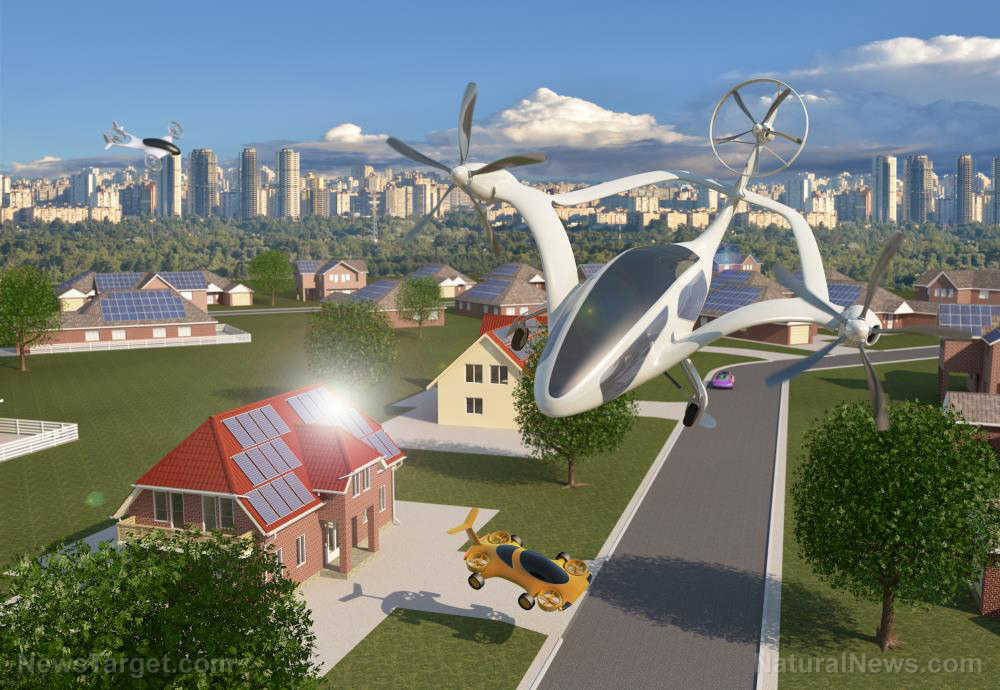Ready for pilot-less flights? German company says self-driving flying cars “in the works”
01/23/2020 / By Arsenio Toledo

German startup Lilium has successfully tested their full-scale prototype electric “flying taxi.” They launched an unmanned test flight of their prototype, proving that their flying taxi’s vertical takeoff and landing (VTOL) systems were functioning properly. The aircraft took off vertically, hovered in the air and then landed safely.
The flying taxi features a relatively simple design. It has an egg-shaped cabin on top of landing gear and it has a pair of parallel tilt-rotor wings. The wings are fitted with 36 electric jet engines that can tilt up for vertical takeoff and then tilt forward for horizontal movement. It has a top speed of 80 mph and has a range of 80 miles. It has a seating capacity of six, five passengers and one pilot. It features no tail, rudder, propellers or gearbox.
Lilium has stated that this minimalist design has allowed their team to focus on developing features that would make the flying taxi more passenger-friendly, such as installing gull-wing doors and panoramic windows so that customers can take in the sights as they are flown to their destination.
Currently, the flying taxi can be operated either by a pilot in the cockpit or be flown remotely in drone mode. Lilium plans to incorporate autonomous flight systems in their flying taxi in the future.
The company believes that by the time their flying taxis are available for commercial use, passengers can get to their destination five times faster compared to taking a land vehicle. Furthermore, their trips would produce less noise than a motorbike, and will be completely emission-free thanks to their electric-powered engines.
Lilium hopes to have a fleet of their flying taxis flying in cities around the world by 2025. It is even designing an on-demand ride-hailing app similar to many ride sharing services like Uber and Lyft. This app would let passengers book a flight from select local landing strips or a landing pad purpose-built for Lilium. The company says this would make short-haul flights more accessible. (Related: Transportation company pitches oversized hydrogen-powered drones as air ambulances or sky taxis.)
More testing
Lilium has a long way to go before their flying taxis are ready for commercial flights. Remo Garber, chief commercial officer of the company, said that he and his team have been working hard for years just to get their take off and landing test to work. Now that they have shown that the five-seater flying taxi’s VTOL systems are functional, more tests need to be done.
“What will come next is a test flight program that will put it through its paces to get certified,” said Garber.
Leandro Bigarella, Lilium’s head of test flights, concurs with Garber’s assessment. “Our flight test program will now continue with increasingly complex maneuvers as we look towards our next big goal of achieving transition flight, which is when the aircraft moves seamlessly from vertical to horizontal flight.”
Lilium’s flying taxi faces stiff competition not just from other flying taxi startups, but from big league companies like Uber and Boeing, who also have plans to develop a viable flying taxi.
The footage of their first successful test flight was released as Lilium celebrated the completion of their first manufacturing facility, located at their Munich headquarters. A second larger facility is being built at the same site. Lilium hopes that these two factories will support their goal of producing hundreds of aircraft per year by the time their flying taxis roll out and begin offering commercial services in 2025.
Sources include:
Tagged Under: air taxi, autmoated cars, breakthrough, driveless cars, flying cars, flying taxi, flying taxis, future cars, future science, future tech, innovation, inventions, robocars, self-driving cars, transportation, vehicles
RECENT NEWS & ARTICLES
COPYRIGHT © 2017 INVENTIONS NEWS



















